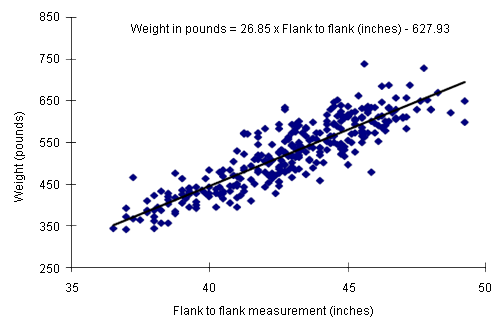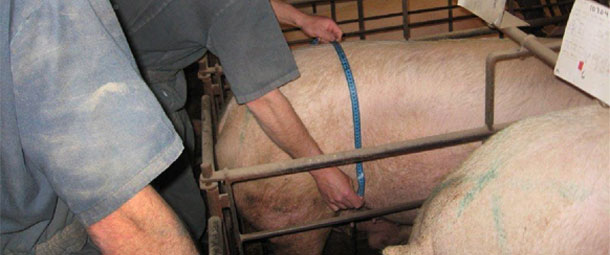Goal
To accurately predict sow body weight by using their flank to flank measurement in order to determine daily feed intake or accurate medication dose.

Description of the trick
Being able to accurately predict sow body weight has many advantages and not knowing it has many disadvantages. The two main advantages are using the correct dosage for injectable drugs and
delivering the correct daily feed intake according to estimated body weight for both sows and developing gilts.
Inconveniences?: I have not found any. As you can see, this process can be carried out very quickly. The predictions are based on a good correlation between the measurement of the distance from one flank to the other just in front of the rear legs. The body weight of the animals is indicated in Graph 1 (Iwasawa T., 2004).

Graph 1. Relationship between the measurement of the distance from one flank to the other one (306 sows from 2 farms with different weights)
This system has been used in those farms that decided to complete a disease eradication using very expensive injectable drugs in a high number of sows. In this situation, the savings associated with the accurate dosing of the product was the most important factor. A quicker way for measuring the sows involves dividing the distance to be measured by two (i.e. half the distance) and only measuring the distance from the spine (i.e. mid-point of the back) to one of the flanks (as shown in the photograph).

The conversion table of these measurments to be used in the farm is as follows:
| Distance flank-flank | Distance flank-spine | Sow weight | |||
| Inches | Centimetres | Inches | Centimetres | Pounds | Kilos |
| 24 | 61 | 12 | 30.5 | 110 | 49.90 |
| 25 | 64 | 12.5 | 32 | 122 | 55.34 |
| 26 | 66 | 13 | 33 | 135 | 61.23 |
| 27 | 69 | 13.5 | 34.5 | 149 | 67.59 |
| 28 | 71 | 14 | 35.5 | 164 | 74.39 |
| 29 | 74 | 14.5 | 37 | 179 | 81.19 |
| 30 | 76 | 15 | 38 | 196 | 88.90 |
| 31 | 79 | 15.5 | 39.5 | 214 | 97.07 |
| 32 | 81 | 16 | 40.5 | 232 | 105.23 |
| 33 | 84 | 16.5 | 42 | 252 | 114.31 |
| 34 | 86 | 17 | 43 | 273 | 123.83 |
| 35 | 89 |
17.5 |
44.5 | 294 | 133.36 |
| 36 | 91 | 18 | 45.5 | 317 | 143.79 |
| 37 | 94 | 18.5 | 47 | 342 | 155.13 |
| 38 | 97 | 19 | 48.5 | 367 | 166.47 |
| 39 | 99 | 19.5 | 49.5 | 394 | 178.72 |
| 40 | 102 | 20 | 51 | 421 | 190.96 |
| 41 | 104 | 20.5 | 52 | 451 | 204.57 |
| 42 | 107 | 21 | 53.5 | 481 | 218.18 |
| 43 | 109 | 21.5 | 54.5 | 513 | 232.69 |
| 44 | 112 | 22 | 56 | 546 | 247.66 |
| 45 | 114 | 22.5 | 57 | 580 | 263.08 |
| 46 | 117 | 23 | 58.5 | 616 | 279.41 |
| 47 | 119 | 23.5 | 59.5 | 654 | 296.65 |
| 48 | 122 | 24 | 61 | 693 | 314.34 |
| 49 | 124 | 24.5 | 62 | 733 | 332.48 |
| 50 | 127 | 25 |
63.5 |
775 | 351.53 |
Ref: Iwasawa T. et al., 2004. Comparison of heart girth or flank to flank measurements for predicting sow weight.




